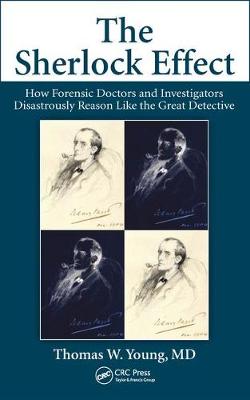(To see other currencies, click on price)
MORE ABOUT THIS BOOK
Main description:
Forensic science is in crisis and at a cross-roads. Movies and television dramas depict forensic heroes with high-tech tools and dazzling intellects who-inside an hour, notwithstanding commercials-piece together past-event puzzles from crime scenes and autopsies. Likewise, Sherlock Holmes-the iconic fictional detective, and the invention of forensic doctor Sir Arthur Conan Doyle-is held up as a paragon of forensic and scientific inspiration-does not "reason forward" as most people do, but "reasons backwards." Put more plainly, rather than learning the train of events and seeing whether the resultant clues match those events, Holmes determines what happened in the past by looking at the clues. Impressive and infallible as this technique appears to be-it must be recognized that infallibility lies only in works of fiction. Reasoning backward does not work in real life: reality is far less tidy.
In courtrooms everywhere, innocent people pay the price of life imitating art, of science following detective fiction. In particular, this book looks at the long and disastrous shadow cast by that icon of deductive reasoning, Sherlock Holmes.
In The Sherlock Effect, author Dr. Thomas W. Young shows why this Sherlock-Holmes-style reasoning does not work and, furthermore, how it can-and has led-to wrongful convictions. Dr. Alan Moritz, one of the early pioneers of forensic pathology in the United States, warned his colleagues in the 1950's about making the Sherlock Holmes error. Little did Moritz realize how widespread the problem would eventually become, involving physicians in all other specialties of medicine and not just forensic pathologists. Dr. Young traces back how this situation evolved, looking back over the history of forensic medicine, revealing the chilling degree to which forensic experts fail us every day.
While Dr. Young did not want to be the one to write this book, he has felt compelled in the interest of science and truth. This book is measured, well-reasoned, accessible, insightful, and-above all-compelling. As such, it is a must-read treatise for forensic doctors, forensic practitioners and students, judges, lawyers adjudicating cases in court, and anyone with an interest in forensic science.
Contents:
1. Reasoning Backwards 2. Sherlock and His Successors 3. Categorical Intuitive Deduction 4. How Detective Fiction Turned Into Medical Science 5. Good Cop, Bad Cop 6. You Don't Know What You Don't Know 7. Can't Shake This Feeling 8. The Emperor Wears No Clothes 9. Broken Bones in Babies 10. The Unified Hypothesis 11. Failing the Infamous 12. The Deadly Bed 13. Failing the Numerous Not-So-Infamous 14. The Double Dip 15. Modern-Day Sherlocks 16. The Battered Football Player Syndrome 17. Tree People and Forest People 18. The Perils of Pediatric Forensic Pathology 19. Kayakers, Spider Bites, Jack the Ripper, and Speaking for the Dead 20. CSI, Adam Ruins Forensic Science, Forensic Tree Teams, and a Bridge in Melbourne 21. Confessions of a Former Chief Medical Examiner
PRODUCT DETAILS
Publisher: Taylor & Francis (CRC Press Inc)
Publication date: May, 2018
Pages: 254
Weight: 557g
Availability: Available
Subcategories: General Issues

